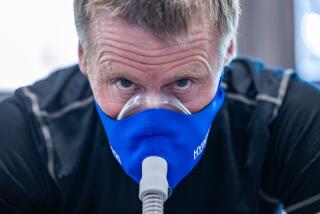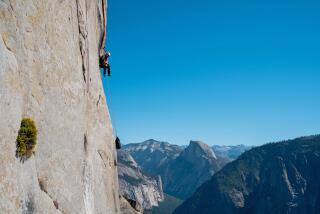NEW HEIGHTS
- Share via
Durango, Colo. — A steel gray cloud booms down thunder and snow flurries over Engineer Mountain in southwestern Colorado. As quick as a lightning flash, an easy day hike on this 13,000-foot peak turns into a frightening adventure.
Making matters worse, the leader of the small climbing expedition, Aron Ralston, is ill-prepared for the trek, wearing only shorts, a short-sleeve shirt and running shoes. He didn’t even bring the prosthetic arm he designed for mountain climbing.
Still, he leaps feet first into giant snow drifts, whooping like a kid playing in the surf. Hanging from the side of a jagged cliff, he pulls himself over with one arm, dangling over a 100-foot drop. All the time, Ralston talks excitedly about the newfound perspective he has on life since self-amputating his right arm in a climbing accident three years earlier.
“This is what I do it for,” he says, catching his breath at the shoulder of the peak, where he surveys a panorama of snow-capped summits.
Three years ago, Ralston was just another outdoor adrenaline junkie, attempting to be the first person to solo climb all 59 of Colorado’s 14,000-foot-plus peaks in winter. During a break from his quest, he ventured into a Utah canyon where an 800-pound boulder rolled onto his right hand, pinning him for six days until he freed himself by severing his arm with a pocketknife. Within a year, he returned to the Colorado Rockies to finish his climbing quest.
Ralston’s outrageous act of nerve has since made him a bestselling author, a beer pitchman, an eco celebrity and a motivational speaker in high demand by corporate America. At 30 years of age, he is one of the nation’s best-known mountaineers. But in the mountain-climbing community, he is the foolhardy adventurer who nearly died after committing the cardinal sin of hiking into the outdoors without leaving word on his whereabouts.
Ironically, the biggest mistake of his life has given Ralston more fame and opportunities than he could have imagined. Ralston has come out of it with a stronger belief in a higher being, a newfound faith in man’s ability to overcome overwhelming odds and an enhanced respect for the outdoors. But he is still an unrepentant thrill seeker. His friends call him Captain Fun Hog because he only feels truly alive when he tiptoes on the edge of danger.
And so, wearing sneakers and shorts, the tall and athletic Ralston scrambles up Engineer Mountain in a snow flurry, cajoling his sandal-wearing pal Chip Stone to join him. Stone makes it halfway up the mountain before turning around, his toes frozen from the snow.
“Nobody tells Aron not to do anything,” Stone says. “He’s the most lust-for-life person I’ve ever known.”
The big mistake
On a warm spring day in 2003, Ralston scampered over a barrel-sized boulder wedged in a narrow granite slot in Utah’s Blue John Canyon.
It was supposed to be an easy day hike, a chance to get away from the numbing-cold temperatures of the Colorado Rockies. But just as Ralston stepped over, the boulder broke free and rolled onto his right hand, pinning him against the canyon wall.
After six days of trying to lift and break the boulder, a dehydrated and delirious Ralston bowed his arm against the chockstone and snapped the radius and ulna bones. Using the dull blade on his multiuse tool, he cut the soft tissue around the break. He then used the tool’s pliers to tear at the tougher tendons.
As he stumbled out of the canyon, his bloody arm wrapped in a plastic grocery sack, Ralston recalled thinking that his story would amaze his friends. But the story astonished the world. In the following days, headlines proclaimed Ralston’s courage: “Trapped Climber Hacks Off Arm.” “Warrior Spirit Saves Climber.” “Toughest Man Alive -- Climber Tells How He Cut Off Own Arm.”
While the rest of the world marveled at his courage, some in the mountaineering community criticized Ralston for failing to abide by the first tenet of outdoor exploration: If you go out alone, tell someone where you are going and when you will be back.
Because Ralston did not do that, his friends and family didn’t call authorities until he had been missing for three days.
Most of Ralston’s criticism came in letters to newspapers and magazines. But some mountaineers have chided him in person. A speaking engagement in Miami last year turned ugly when someone in the audience accused Ralston of profiting from a dumb mistake, prompting Ralston’s fans to shout down the critic.
Ralston has softened some of the criticism by admitting his mistake. As a search and rescue volunteer in Colorado, he knows what he did was foolish, and he vows never to repeat that mistake again.
It wasn’t the first time Ralston’s overconfidence got him into trouble. A few weeks before his Utah accident, he barely survived a Colorado avalanche that he and two ski buddies triggered.
In the first few days after the accident, reporters, literary agents and Hollywood producers hounded Ralston for a piece of his story. He estimated that he told it about 150 times. With every retelling, he relived those awful hours when he was certain he was going to die alone in that cold canyon.
But he also discovered the inspirational power of his story. During his recovery, a woman from Salt Lake City wrote to Ralston, telling him she gave up plans to commit suicide after reading about his fight to survive.
It was the first of a number of letters from depressed and suicidal fans.
“I’m convinced that this was a miracle, that it was given to me to share with other people,” he said of his escape.
Within three months of the accident, Ralston wrote the outline of a book. A year later, “Between a Rock and a Hard Place” became a national bestseller. He went on a nationwide publicity tour that included interviews with David Letterman, Jane Pauley, Tom Brokaw and Howard Stern.
Ten months and five surgeries after the accident, Ralston was back in the Colorado Rockies, climbing the last 14 peaks in his quest, aided by a specially designed prosthetic arm with an ice ax mounted on the end.
As his fame spread, his demand as a motivational speaker and outdoor-gear spokesman grew. And with it grew his chances to make money. But Ralston said he did not accept every offer that came his way.
“That seemed like too much work,” he says, “and I’m not a big fan of work.”
He has spoken free of charge to disabled veterans, mentally disabled children and environmental groups. He charged hefty fees to big corporations, speaking before them on the condition that Captain Fun Hog would have some fun. He spoke, for example, at Hewlett-Packard’s annual conference recently because it was held in Hawaii, where he hung out on the beach with his girlfriend.
With the prospects of more fun, Ralston accepted a role in a series of Miller Lite TV ads that also featured actor Burt Reynolds, pro football star Jerome Bettis and comedian Eddie Griffin. Never mind that Ralston doesn’t drink alcohol. He took the six-figure job, he said, because he couldn’t pass up the chance to crack jokes with Reynolds and the gang of macho celebrities.
Ralston got the job, according to Pete Marino, a Miller Brewing Co. spokesman, because he epitomizes what it means to be a man.
“The guy cut off his own arm to save his life,” he said. “He knows how men need to act.”
The view from here
On a warm Thursday evening, Ralston stands on the stage of a small auditorium in Durango, giving a talk and slide show to a crowd of about 500 people. The event is a fundraiser for a group trying to stop a Vail-type development at Wolf Creek in Colorado’s Rio Grande National Forest.
An engineer by training, Ralston looks more like a carefree college kid with an unkempt mane of red hair and an untucked dress shirt.
Slicing off his own hand took nerve, he says, but it took more courage to give up the security of a full-time job at computer-chip giant Intel in 2002 to chase his outdoor pursuits.
During most of his two-hour slide show he talks about his seven-year quest to climb all of Colorado’s 14,000-plus peaks. He describes the numerous setbacks, such as the frostbite he suffered in 2003 on the same hand he would later amputate.
This unprecedented mountaineering quest was supposed to set him apart in the mountaineering community. Instead, it is overshadowed by his greatest blunder.
The giant screen behind him flashes a self-shot photo of Ralston, looking gaunt, his arm pinned under a boulder. It was late April 2003. Several times during his internment in Blue John Canyon, he says, he felt like giving in to death. And he came close. He survived on 20 ounces of water for six days, lost 40 pounds and, at the end, drank his own urine to keep from dehydrating.
After he amputated his arm, Ralston tells the audience he had the overwhelming urge to take a nap in the shade.
“I knew that if I did that, there would be no more,” he says in a low voice. “No more waking up. No more opportunities. And so it was that determination and perseverance and courage that helped me take one more step, one more step, one more step....”
As with other motivational talks, Ralston hammers on the importance of persistence and courage. Persistence and courage, he tells the audience, will save Wolf Creek from development.
After the lecture, Ralston spends nearly two hours autographing copies of his book for a line of people that stretches to the back of the theater.
Among his fans is 13-year-old Sarah Ford, who asks Ralston to autograph a copy of his book to replace the dogeared volume at her Durango classroom. Though she is just a teen, Ford says Ralston’s message resonates with her.
“Live for the moment,” she says. “We are not going to be here forever.”
Once the crowd has gone, Ralston packs up his books and slide show. His escape from Blue John Canyon was a miracle, he says, but it’s not the final chapter in his life.
In a couple of years, he hopes to climb K2, the world’s second-highest mountain, with a team of American and Pakistani climbers to promote peace between the Christian and Muslim worlds.
“I wouldn’t want to be remembered for the biggest mistake of my life. I’m glad it has resulted in people finding a path in their lives and gaining perspective,” he says, but adds, “I don’t want that to be my watershed moment when I’m 60.”
More to Read
Sign up for The Wild
We’ll help you find the best places to hike, bike and run, as well as the perfect silent spots for meditation and yoga.
You may occasionally receive promotional content from the Los Angeles Times.







